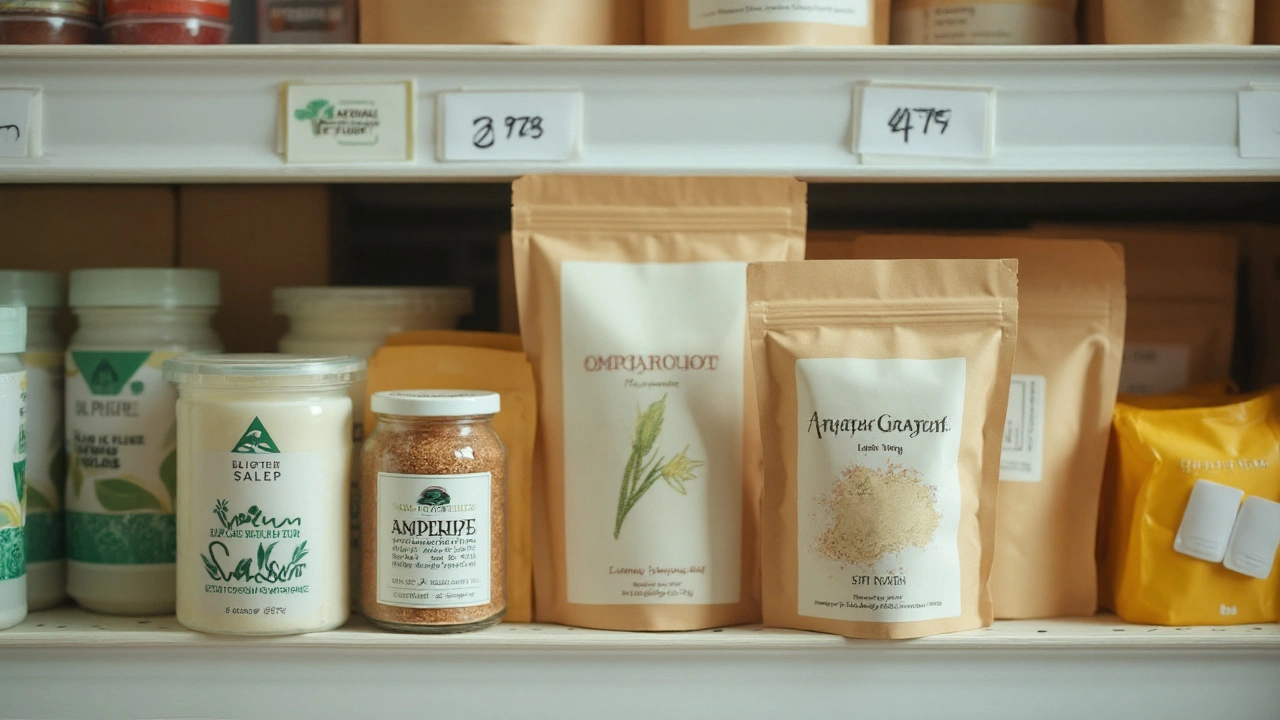- TL;DR: Salep is a traditional orchid-root flour rich in glucomannan-like fiber. It can soothe the throat, support digestion, and help fullness, but evidence is limited vs konjac or psyllium.
- Use it as a warm drink or thickener, start low (0.5-1 g) and hydrate well. Keep it 2 hours away from medicines.
- Real salep is hard to source and often restricted; many instant “salep” mixes are sugar and starch. Consider cultivated sources or proven alternatives.
- If weight loss is your goal, konjac glucomannan and psyllium have stronger clinical backing than salep.
- Buy ethically: orchids are protected. Look for cultivation, transparency, and third-party testing-or choose sustainable substitutes.
You came here to find out if salep can be your quiet edge: better digestion, a calmer throat on cold days, maybe a nudge toward feeling full without another snack. It can help with some of that. But here’s the real story: genuine salep is rare, regulations around orchids are strict, and the science is lighter than the hype. You’ll get clear benefits, safe ways to use it, and smart alternatives when you can’t find the real deal.
What Salep Is, What It Can (and Can’t) Do
Salep (also spelled sahlab) is a flour made from the dried tubers of certain wild orchids (Orchis and related species). It’s the thick, silky backbone of classic Turkish winter drinks and that stretchy Middle Eastern ice cream (dondurma). The texture comes from mucilage-long-chain fibers rich in glucomannan, the same family of soluble fibers that give konjac its famous gelling power.
That texture matters. Soluble, viscous fibers slow gastric emptying and can blunt post-meal glucose spikes. They also feed gut bacteria and boost satiety. That’s why people reach for salep when they want something soothing, filling, and gentle on the gut. The catch: most clinical studies are on konjac glucomannan or psyllium, not salep itself. Salep’s fiber behaves similarly, but the evidence specifically on salep is small and mostly traditional use reports rather than large trials.
So what benefits can you expect, realistically?
- Comfort for the throat and stomach: Demulcent fibers form a soothing gel. Many folks use a warm salep drink when they’re raspy or refluxy. This is a long-standing traditional use. It makes sense physiologically, even if trials are scarce.
- Fullness and appetite control: Viscous fiber swells in water. You feel satisfied sooner. Glucomannan has European approval for supporting weight loss on a reduced-energy diet (EFSA, 2010). Salep likely nudges fullness in the same direction, but you shouldn’t expect dramatic fat loss from salep alone.
- Digestive regularity: Soluble fiber supports softer stools and steadier transit time, especially if your diet is low in fiber. Go slow to avoid gas at first.
- Cholesterol support: Viscous fibers can lower LDL by binding bile acids. Oat beta-glucan and psyllium have strong data; glucomannan shows benefit too. Salep may help modestly, but it hasn’t been studied enough to claim the same effect.
And the limits?
- Evidence: Salep-specific RCTs are rare. If your top priority is weight management or LDL reduction, psyllium and konjac have a deeper evidence base.
- Availability and legality: Turkey restricts the export of real salep to protect wild orchids. Many supermarket “salep” packets are sugar, starch, and spices with little or no orchid content.
- Sustainability: Wild orchid populations have been damaged by overharvesting. Buying cultivated salep or certified alternatives is the responsible route.
Bottom line: use salep as a soothing, functional comfort drink and light satiety aid. If you need clinically proven fiber for a specific target (weight, LDL), consider pairing salep with psyllium or konjac-or using those as primary fibers.
Quick note on taste and texture: salep tastes mild and slightly floral, more about body than flavor. Think cozy, creamy, and a little stretchy-like a hug in a mug if you dial the ratio right.

How to Use Salep Safely: Doses, Prep, and Smart Stacking
Jobs-to-be-done here are simple: get a safe dose, prepare it the right way, fit it into your eating pattern, and avoid the common pitfalls (like turning your kitchen into a glue factory, or worse, choking on dry powder).
Practical dose ranges
- Starter dose: 0.5 g in a hot drink (about 1/4 teaspoon if your powder is fluffy), once per day. This is for feel and tolerance.
- Typical use: 1-2 g per serving in a warm beverage or smoothie, up to twice per day.
- Upper practical limit: 3 g per day split into two or three servings. Drink a full glass of water with it. More is not better; viscosity rises fast.
Why those numbers? Glucomannan’s weight support data use 3 g/day split before meals (EFSA, 2010). Salep delivers similar fiber chemistry but is less standardized. Starting lower keeps bloating and bathroom surprises off your calendar.
Timing
- For satiety: Take 15-30 minutes before meals in a warm drink.
- For throat comfort: Sip warm salep with a bit of honey and cinnamon as needed.
- Around training: Not ideal right before a workout; it can feel heavy. Better with your post-workout snack to steady hunger.
Prep: two foolproof methods
- Classic warm cup (barista-smooth): Whisk 1 g salep into 250 ml cold milk (or plant milk) until lump-free. Warm gently, stirring constantly, until it thickens slightly. Sweeten lightly (maple, honey) and add cinnamon or cardamom. Keep it sippable; if it turns stretchy like taffy, you added too much.
- Quick blender hack (no clumps): Blend 1 g salep with 250 ml hot water or hot milk, plus a pinch of cinnamon. The blender disperses the powder before gelling. Pour and enjoy.
Two real-life recipes
- Evening wind-down: 1 g salep, 250 ml oat milk, 1 tsp honey, pinch of cinnamon. Gentle heat, slow sip, screens off.
- Breakfast booster: 1 g salep, espresso shot, 200 ml warm milk, 1 tsp cocoa, zero-cal sweetener if you like. It’s like a lighter mocha with staying power.
Hydration and safety rules
- Always take with plenty of liquid. Dry spoonfuls are a choking risk. Mix thoroughly before sipping.
- Separate from medicines and supplements by at least 2 hours. Viscous fiber can affect absorption. This matters for thyroid meds, diabetes meds, and fat-soluble vitamins.
- If you have diabetes or prediabetes: fiber can lower post-meal glucose. Track your numbers and talk to your clinician about dose and timing alongside meds.
- Pregnancy and nursing: stick to culinary amounts unless your clinician okays more. Data are limited.
- Allergies are rare but possible. Start low and watch for itching, swelling, or breathing changes. Stop and seek care if anything feels off.
Stacking salep with other fibers
- For weight management: Pair a small salep drink with psyllium (2-3 g) or konjac (1 g) before your main meal. You’ll get better satiety with lower salep use.
- For cholesterol: Consider oats (3 g beta-glucan/day) or psyllium (7-10 g/day) as your main fiber. Use salep for comfort and variety.
- For gut comfort: Add fermented foods (yogurt, kefir, kimchi) and diverse plants. Salep is a helper, not the whole plan.
How to avoid the common pitfalls
- Gloop disaster: If your drink turns into pudding, you used too much or heated too fast. Keep it under 2 g per 250 ml and whisk before heating.
- Bloating: Back the dose down to 0.5 g for a week and build up. Add water and a short walk after drinking.
- Hidden sugar: Instant “salep” sachets can pack 10-20 g sugar per serving. Read the label. Make your own and sweeten lightly.
- Weak product: If your “salep” doesn’t thicken at all, it might be starch with flavor. Look for reputable sources and clear labeling.
What the science actually says (without the fluff)
- Glucomannan: Multiple randomized trials show small but meaningful reductions in body weight when 3 g/day is used with calorie control; it also lowers LDL. This underpins the EFSA opinion in 2010 supporting the weight-loss claim under energy restriction.
- Psyllium: Strong evidence for LDL reduction and regularity; endorsed by cardiology guidelines as a therapeutic dietary fiber adjunct.
- Salep: Traditional use is strong; modern trials are sparse. Its mucilage is glucomannan-rich, so effects likely mirror glucomannan at lower intensity per gram due to product variability.
| Fiber source | Typical soluble fiber content | Evidence for weight | Evidence for LDL | Taste/texture | Availability (2025) | Sustainability risk | Notes |
|---|---|---|---|---|---|---|---|
| Salep (orchid tuber) | High viscosity; glucomannan-rich mucilage (varies by species/batch) | Limited direct trials; likely modest via fullness | Suggestive but not well-studied | Mild, floral, creamy; can get stretchy | Restricted; many retail mixes are sugar/starch | High if wild-harvested; choose cultivated | Export restrictions apply in Turkey; check provenance |
| Konjac glucomannan | Very high soluble fiber (>80%) | Moderate evidence; 3 g/day supports weight loss with diet | Good evidence for LDL reduction | Neutral taste; jelly-like if overused | Widely available as powder/capsules | Low | Standardized products make dosing easier |
| Psyllium husk | High soluble fiber (~70-80%) | Moderate evidence for satiety/weight | Strong evidence for LDL reduction | Mild; can be gritty if not blended | Very common | Low | Affordable; great baseline fiber |
| Oat beta-glucan | Moderate soluble fiber (varies by product) | Modest weight support | Strong evidence for LDL reduction | Oaty, pleasant | Common (oats, concentrates) | Low | Synergizes with other fibers |
Credibility notes: EFSA (2010) supports glucomannan for weight loss with energy restriction; lipid guidance from major cardiac societies points to soluble fibers like psyllium and beta-glucan; orchids are covered under CITES listings, prompting tight controls. These aren’t brand claims-they’re regulatory and guideline positions.

How to Buy Right: Quality, Sustainability, and Credible Alternatives
Now to the hardest part: getting the good stuff without stepping on orchids or your wallet. Most people click away disappointed because they realize their “salep” is flavored sugar. Here’s how to avoid that, and what to use if you can’t source the real thing.
Quick buying checklist
- Ingredient list: Should say salep/orchid tuber (Orchis spp. or related). If sugar and starch show up first, it’s a dessert mix, not a supplement.
- Origin and cultivation: Look for “cultivated” or farmed sources. Avoid “wildcrafted” orchid-this often signals unsustainable harvesting.
- Transparency: Batch testing, microbial safety, heavy metal checks. Ask for a Certificate of Analysis if the supplier claims “supplement grade.”
- Form: Pure powder is most versatile. Capsules are convenient but can underdose; check mg per capsule.
- Price reality: Genuine cultivated salep is expensive. Rock-bottom prices usually mean blends or substitutes.
Label traps to sidestep
- “Instant salep” or “salep drink mix”: Often a cozy winter beverage with sugar, not a functional fiber supplement.
- “Turkish flavor” or “sahlab flavor”: That’s an aroma added to starch.
- “Herbal thickener blend”: Usually starches and gums with trace salep.
Sustainability and legal context in plain English
- Turkey and several regions restrict the export of real salep to protect wild orchids. Many orchids are covered by international trade controls (CITES). That’s why genuine salep is scarce outside its home regions.
- If a seller ships bulk “wild salep” worldwide at bargain prices, be skeptical.
- Best practice: support cultivated, transparent producers-or choose alternatives with equal or better health effects.
Best alternatives when you can’t find cultivated salep
- Konjac glucomannan powder: The closest match for viscosity and satiety, with stronger clinical backing. Start with 500-1000 mg in 250-300 ml water before meals. Hydrate well.
- Psyllium husk: Excellent for LDL and regularity. 2-3 g before meals for satiety; 7-10 g/day for cholesterol support, split through the day.
- Oat beta-glucan: Gentle on the gut and easy to add to smoothies or porridge. Aim for 3 g beta-glucan/day for cholesterol.
Decision helper: Which should you pick?
- Comfort drink and tradition: Choose salep when cultivated and verified.
- Weight focus: Konjac first, psyllium second. Add spices to mimic salep’s cozy vibe.
- Cholesterol focus: Psyllium or oat beta-glucan as primary fiber.
- Budget: Psyllium wins.
- Texture preference: Salep for creamy; psyllium for light gel; konjac for strong gel; oats for silky.
How to build a simple plan that actually sticks
- Pick one anchor fiber and use it daily for two weeks. Consistency beats variety.
- Layer salep as your evening ritual drink 3-4 nights a week if you enjoy it and tolerate it.
- Track one metric that matters to you: appetite ratings, waist measurement, bathroom regularity, or LDL if you’re working with your clinician.
FAQ (quick hits you probably care about)
- Is salep the same as sahlab? Same idea. “Salep” in Turkish, “sahlab” in Arabic. Both point to orchid-root flour drinks, though recipes vary by region.
- Does it help with weight loss? It can help you feel full, which supports eating less. For actual weight change, pair it with a calorie plan. Konjac and psyllium still have stronger proof.
- Can kids have it? In culinary amounts as a warm drink, usually fine. Avoid supplement-level doses without pediatric guidance.
- Is it vegan? The powder is plant-based. Some traditional recipes use dairy; plant milks work well.
- Any drug interactions? Separate by 2 hours from meds and supplements to avoid absorption issues. If you’re on diabetes meds or thyroid hormone, ask your clinician about timing.
- What if I can’t find real salep? Use konjac or psyllium for function. For flavor, add cinnamon, cardamom, and a touch of vanilla.
- Why doesn’t my “salep” thicken? Likely a dessert mix or underdosed powder. Try 1-2 g per 250 ml and whisk properly.
Next steps and troubleshooting
- If you’re brand new to viscous fibers: run a two-week experiment. Days 1-3: 0.5 g salep in the evening. Days 4-7: 1 g. Days 8-14: 1-2 g before your biggest meal. Log hunger (1-10) and bathroom comfort.
- If you want weight results by a deadline: switch your daytime doses to standardized konjac (3 x 1 g before meals) and keep a small salep drink at night for comfort. Recheck weight and waist in 4 weeks.
- If you get bloating or cramps: halve the dose and double fluids. Add a 10-minute walk after your drink. If symptoms persist, stop and pivot to psyllium or oats.
- If ethics and sustainability are your top concern: choose psyllium or oats as your primary fiber and enjoy a salep-style drink made with spices and a dash of konjac for thickening. Traditions matter, and so do orchids.
- If your lab goal is LDL: run psyllium 7-10 g/day for 8-12 weeks, keep diet steady, and recheck labs with your clinician.
One final sanity check: supplements amplify habits; they don’t replace them. Eat plants, drink water, move your body. Save salep for the times a warm, velvety cup helps you stay on track. That’s where it shines.
How to spot the real thing at a glance
- The powder should be fine and off-white to light beige, with a neutral scent.
- A teaspoon in a cup of warm milk should start to thicken within a few minutes with stirring.
- Labels should mention orchid species, cultivation, and net salep percent if it’s a blend.
Storage and shelf life
- Keep it in a cool, dry, dark place.
- Seal tightly; moisture triggers clumping and spoilage.
- Use within 6-12 months for best texture and potency.
If you want a simple starter kit for your kitchen ritual
- Small digital scale (0.01 g resolution) so you don’t overdose.
- Mini whisk or milk frother for smooth mixing.
- Spice tin with cinnamon, cardamom, and vanilla powder.
And yes, taste matters. If you love the ritual, you’ll keep it. That, more than any claim on a label, is what changes your day.
I’ll leave you with a tiny tip: brew your evening cup five minutes before you want it. That short wait lets the drink set into its perfect, silky body-no clumps, no sludge, just calm.
One-time SEO note for clarity: if you’re searching for salep powder and only finding instant mixes, try adding “cultivated orchid” or “glucomannan alternative” to your search. It’ll save you time.





Tammy Sinz
September 3, 2025 AT 15:30Salep’s mucilaginous polysaccharides, primarily glucomannan analogues, confer a high-viscosity matrix that decelerates gastric emptying, thereby modulating postprandial glycemic excursions. The fiber's fermentability also supports a selective proliferation of bifidogenic taxa, enhancing short-chain fatty acid production. From a pharmacodynamic perspective, the demulcent action on mucosal epithelia can attenuate cough reflex sensitivity in upper respiratory irritation. However, the paucity of double‑blind, placebo‑controlled trials limits extrapolation of these mechanistic benefits to clinically meaningful outcomes. In practice, a starter dose of 0.5 g administered in a warm beverage aligns with safety thresholds established for related glucomannan sources. Hydration is critical; inadequate fluid intake predisposes to esophageal obstruction. Users should observe a two‑hour separation from concomitant medications to avoid absorption interference. Ultimately, while the biophysical properties are promising, the evidence hierarchy remains inferior to that of konjac and psyllium.
Christa Wilson
September 3, 2025 AT 16:53Love the idea of a cozy nightly cup! ☕️😊 Just start with a pinch and you’ll feel the soothing vibe in no time.
John Connolly
September 3, 2025 AT 19:06From a practical standpoint, treat salep as you would any soluble fiber supplement: measure precisely, mix thoroughly, and consume with ample liquid. The 1–2 g dosage range fits comfortably between the lower threshold for gut comfort and the upper limit where viscosity becomes problematic. Pairing it with a balanced breakfast smoothie can deliver both texture and a modest satiety boost. If your primary goal is lipid management, consider allocating the bulk of your fiber budget to psyllium or oat beta‑glucan, which have robust clinical data. Nevertheless, salep can serve as a flavorful adjunct for those who appreciate its traditional heritage.
WILLIS jotrin
September 3, 2025 AT 21:36There’s something almost meditative about watching a cup of salep thicken, a slow reminder that change in the body is rarely instant. It bridges the gap between taste and function, making the act of drinking a small ritual rather than a mere nutritional fix. If you keep the preparation gentle, the fiber’s impact on gastric emptying can be subtle yet steady. In that way, salep mirrors many philosophical concepts: modest, patient, and ultimately rewarding.
Kiara Gerardino
September 4, 2025 AT 00:23Ah, salep – the aristocratic veil draped over the humble world of dietary fibers, a concoction as pretentious as it is misunderstood. Let us dissect this opulent powder with the rigor it deserves, for it masquerades as a miracle while hiding behind a shroud of scarcity and exotic mystique. First, its lineage traces back to the endangered bulbs of wild orchids, a fact that should invoke a collective gasp of moral outrage rather than a casual sip of nostalgia. The very act of harvesting these tubers is an affront to biodiversity, a reckless gamble on the survival of flora that have stood the test of centuries. Yet the market, ever hungry for the exotic, commodifies this rarity, selling sachets that often contain nothing more than sugar, starch, and a whisper of flavor – a blatant deception, a culinary charade. The scientific community, with its unflinching gaze, reveals that salep’s glucomannan‑like fibers, while theoretically beneficial, lack the rigorous trial backing that konjac or psyllium boast. One must ask: why cling to an inferior alternative when superior, evidence‑based options exist? The answer, dear readers, lies in the seductive allure of tradition, the romanticism of a steaming cup that recalls ancient bazaars. But romance, when pitted against responsibility, should always yield to the latter. In terms of dosage, the recommended 0.5‑2 g is merely a nod to safety, a thin veil over the potential for gastrointestinal distress if misused. The requirement to hydrate abundantly is not a suggestion but a mandate; failure to do so courts the very real danger of obstruction. Moreover, the mandated two‑hour gap from medication ingestion is a safeguard against the fiber’s meddlesome interference with drug absorption – another reminder that salep is not a benign additive but an active participant in physiological processes. Ultimately, the truth gleams starkly: salep is a luxury, an indulgent novelty that offers modest benefits at best, while exacting a heavy ethical and ecological price. For those truly seeking health benefits, the prudent path lies with responsibly sourced, clinically validated fibers. Embrace wisdom over whimsy; let the exotic be admired from afar, not consumed with reckless abandon.
Rachael Turner
September 4, 2025 AT 03:26The way salep thickens feels like a slow bloom of comfort without too much lab talk its effect on fullness is subtle but real you just need to give your gut time to adapt the fiber can be a gentle ally if you stay hydrated and respect the dosing guidelines
Vin Alls
September 4, 2025 AT 06:46Picture this: a dash of orchid‑derived powder swirling into steaming milk, turning ordinary liquid into a velvety cloud of health‑boosting mucilage. That’s the magic of salep, a natural thickener that whispers rather than shouts. It offers a modest satiety signal, nudging you away from late‑night snacking without the drama of high‑tech supplements. Pair it with a pinch of cinnamon or a drizzle of honey, and you’ve got a ritual that’s both tasty and functional. Still, if your goal is hardcore cholesterol control or weight loss, the proven powerhouses – psyllium, konjac, oat beta‑glucan – should take center stage.
Tiffany Davis
September 4, 2025 AT 10:23I’ve tried the simple recipe with oat milk and a teaspoon of honey; the texture was smooth and the flavor subtle. It’s a nice occasional treat, though I keep the serving size modest to avoid any bloating. For daily fiber needs I still rely on a standard psyllium supplement. The approach works fine for my routine.
Don Goodman-Wilson
September 4, 2025 AT 14:16Oh sure, let’s all splash some exotic powder in our coffee and pretend it’s a health breakthrough. Meanwhile, the real data sits on the shelf while people chase the warm‑and‑fluffy hype. If you want results, grab the clinically backed fibers instead of this novelty act.
Bret Toadabush
September 4, 2025 AT 18:26dont trust those big pharma labs they hide the truth about salep its a real cure but they keep it hidden its a secret they dont want you to know its allll about control and all the big corp is lying about the safety they want us to buy the fake sugar mixes thats why i use the real stuff from the underground source
Diane Thurman
September 4, 2025 AT 22:36salep is just a fad it doesnt do what ppl say it does